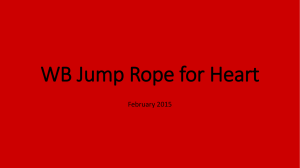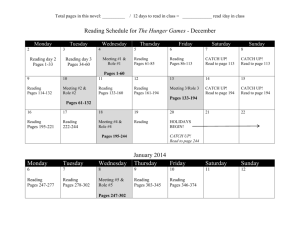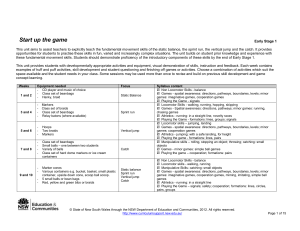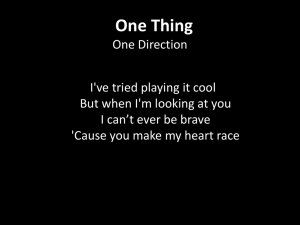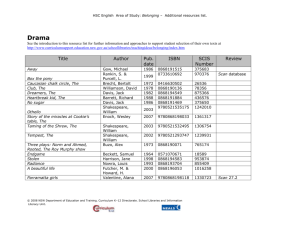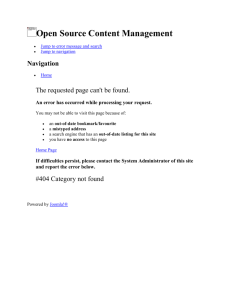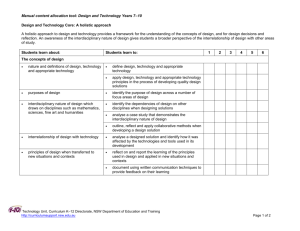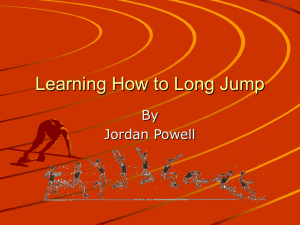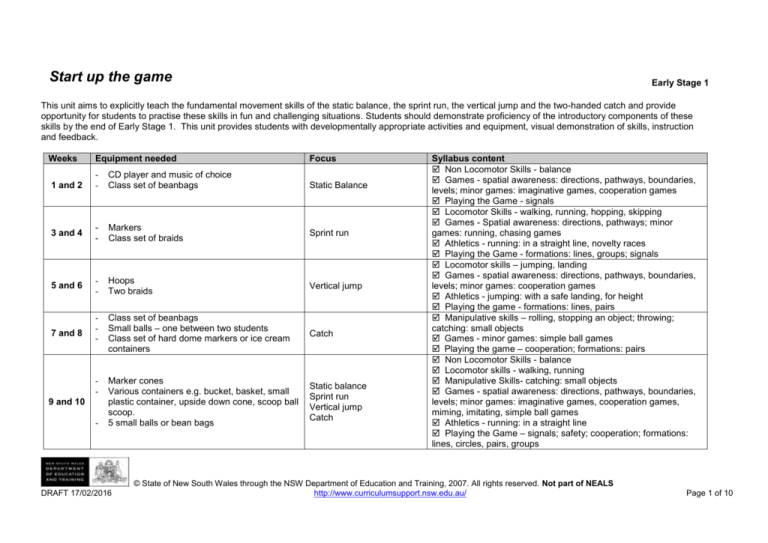
Start up the game
Early Stage 1
This unit aims to explicitly teach the fundamental movement skills of the static balance, the sprint run, the vertical jump and the two-handed catch and provide
opportunity for students to practise these skills in fun and challenging situations. Students should demonstrate proficiency of the introductory components of these
skills by the end of Early Stage 1. This unit provides students with developmentally appropriate activities and equipment, visual demonstration of skills, instruction
and feedback.
Weeks
Equipment needed
1 and 2
-
CD player and music of choice
Class set of beanbags
3 and 4
-
Markers
Class set of braids
Sprint run
5 and 6
-
Hoops
Two braids
Vertical jump
-
Class set of beanbags
Small balls – one between two students
Class set of hard dome markers or ice cream
containers
Catch
-
Marker cones
Various containers e.g. bucket, basket, small
plastic container, upside down cone, scoop ball
scoop.
5 small balls or bean bags
Static balance
Sprint run
Vertical jump
Catch
7 and 8
9 and 10
-
DRAFT 17/02/2016
Focus
Static Balance
Syllabus content
Non Locomotor Skills - balance
Games - spatial awareness: directions, pathways, boundaries,
levels; minor games: imaginative games, cooperation games
Playing the Game - signals
Locomotor Skills - walking, running, hopping, skipping
Games - Spatial awareness: directions, pathways; minor
games: running, chasing games
Athletics - running: in a straight line, novelty races
Playing the Game - formations: lines, groups; signals
Locomotor skills – jumping, landing
Games - spatial awareness: directions, pathways, boundaries,
levels; minor games: cooperation games
Athletics - jumping: with a safe landing, for height
Playing the game - formations: lines, pairs
Manipulative skills – rolling, stopping an object; throwing;
catching: small objects
Games - minor games: simple ball games
Playing the game – cooperation; formations: pairs
Non Locomotor Skills - balance
Locomotor skills - walking, running
Manipulative Skills- catching: small objects
Games - spatial awareness: directions, pathways, boundaries,
levels; minor games: imaginative games, cooperation games,
miming, imitating, simple ball games
Athletics - running: in a straight line
Playing the Game – signals; safety; cooperation; formations:
lines, circles, pairs, groups
© State of New South Wales through the NSW Department of Education and Training, 2007. All rights reserved. Not part of NEALS
http://www.curriculumsupport.nsw.edu.au/
Page 1 of 10
Outcomes and indicators
GSES1.8 Demonstrates fundamental
movement skills while playing with and
sharing equipment
shows understanding of the
language used in games by
responding to verbal and nonverbal
directions
ALES1.6 Develops a repertoire of physical
activities in which they can participate.
takes part in different types of
physical activity
MOES1.4 Demonstrates a general
awareness of how basic movement skills
apply in play and other introductory
movement experiences
maintains stillness of head and trunk
when balancing
Learning experience
Weeks 1 and 2 -Static balance
Getting Started
Play the game Statues.
Students move around the designated space to music. When the music stops, the students keep
the position they are in to make a statue.
Variations: vary the locomotor movement e.g. skip, hop, gallop, jump.
Call various instructions for the type of statue to be made. These could include:
- one leg
- arms high
- arms low
- arms to the side
- two feet one hand
- one foot two hands
- one foot one hand
Developing balance
Introduce the static balance.
Demonstrate a static balance to the students and outline the following key components.
1. Support leg still, foot flat on the ground.
2. Non-support leg bent, not touching the support leg.
3. Head stable, eyes focused forward.
4. Trunk stable and upright.
5. No excessive arm movements.
(Introductory components marked in bold)
Balance 1
Ask students to perform a static balance. Use the following teaching cues:
• Stand still with your foot flat on the ground.
• Hold your bent leg away from your other leg.
• Look at something in front of you.
• Stand up tall when you balance.
• Relax your arms.
Ask questions such as:
- What is needed for good balance?
DRAFT 17/02/2016
© State of New South Wales through the NSW Department of Education and Training, 2007. All rights reserved. Not part of NEALS
http://www.curriculumsupport.nsw.edu.au/
Planned assessment and
teaching notes
Balance is an essential
prerequisite of almost all
movement skills. A static balance
is defined as being able to
maintain a stationary position
throughout the movement. The
ability to perform a stationary
balance for a specific period of
time has been linked to a
reduced risk of suffering from
falls, which may lead to bone
fractures in older individuals.
The focus in ES1 should be on
the introductory components of
the static balance:
- non support leg bent, not
touching the support leg
- head stable eyes focussed
forward
- trunk stable and upright
By the end of Early Stage 1
students should demonstrate
proficiency in these components.
Refer to Get skilled: Get active
page 18 for further information
about the static balance or use
this link.
Page 2 of 10
Outcomes and indicators
Learning experience
- Why is it easier to balance with your hands held out?
- Why is it easier if you look at something in front of you?
Balance 2
Ask students to stand with one foot in front of the other. The heel of the foot in front
touching the toe of the foot behind.
Ask students to:
- hold arms out to the side
- place hands on hips
- balance a bean bag on their head
- repeat these activities on the other leg.
Ask students which leg was easier to balance on. This will be their preferred leg.
Students try balancing a bean bag on various body parts while balancing on one leg e.g. hands,
knee, foot, head, shoulder, elbow.
Beanbag balance – scatter beanbags around a designated area. Students move around the area
to music. When the call of a different body part is made, students find a beanbag perform a
balance with the beanbag on the specified body part.
Variations: vary the locomotor movements; make calls to change directions and speeds.
Planned assessment and
teaching notes
Assessment strategy
The teacher:
observes students
performing the static
balance
Assessment criteria
The student:
bends their nonsupport leg without
touching the support
leg
keeps head stable
and eyes focused
forward
keeps trunk stable
and upright
responds to verbal
and non-verbal cues
These criteria relate to
outcomes MOES1.4 and
GSES1.8
Finishing off
Play a game of Simon says. Call instructions such as ‘Simon says balance on one leg, Simon
says put your hands out to the side; put your hands in the air. Students who do not do what
Simon says are chosen to make the next call.
GSES1.8 Demonstrates fundamental
movement skills while playing with and
sharing equipment
shows understanding of the
language used in games by
responding to verbal and nonverbal
directions
MOES1.4 Demonstrates a general
awareness of how basic movement skills
DRAFT 17/02/2016
Weeks 3 and 4- Sprint run
Getting started
Play the game Follow the leader. Select a student to be the leader. They move around the
playground using different types of locomotion and running styles e.g. lift your knees high, touch
your bottom with the heels of your foot, run on your toes, jog on the spot, run stiffly like a wooden
person, run while clapping hands.
Introducing the sprint run
Demonstrate the sprint run to the students, outlining the following components.
1. Lands on ball of the foot.
© State of New South Wales through the NSW Department of Education and Training, 2007. All rights reserved. Not part of NEALS
http://www.curriculumsupport.nsw.edu.au/
The sprint run is a locomotor skill.
The ability to perform a sprint run
is fundamental to many games,
sports and everyday activities.
The focus in Early Stage 1
should be on the introductory
components of the sprint run:
- high knee lift (thigh almost
parallel to the ground)
- head and trunk stable, eyes
Page 3 of 10
Outcomes and indicators
Learning experience
Planned assessment and
teaching notes
apply in play and other introductory
movement experiences
2. Non-support knee bends at least 90 degrees during the recovery phase.
3. High knee lift (thigh almost parallel to the ground).
4. Head and trunk stable, eyes focused forward.
5. Elbows bent at 90 degrees.
6. Arms drive forward and back in opposition to the legs.
(Introductory components marked in bold)
focused forward
- arms drive forward and back in
opposition to the legs.
demonstrates balance and high knee
lift when sprinting
ALES1.6 Develops a repertoire of physical
activities in which they can participate
takes part in different types of
physical activity e.g. running
Ask the students to try running:
- while driving their arms forward and back in rhythm with their leg movements
- while looking up in the air
- while looking down to the ground
- watching a partner who is running beside them
- looking straight ahead
- with straight arms
- with bent arms.
Following the activity, ask questions like:
- Is it easier to run looking up, down or straight ahead? Why?
- Did your arms help you to run?
- How do your arms help? Why?
- Was it easier to run with your arms bent or straight? Why?
Practising the sprint run
As a class, ask students to run on the spot. Practise swinging with bent
arms, lifting legs up high and running up a hill, running on the balls (front
part) of their foot.
Mark out two lines about 20m apart. Ask students to run from one line to
another concentrating on one component at a time. Use the following
teaching cues:
• Lift your knees high.
• Bring your heel close to your bottom.
• Look ahead.
• Make your feet follow an imaginary straight line.
• Don’t let your heels touch the ground.
• Land on the balls of your feet.
DRAFT 17/02/2016
© State of New South Wales through the NSW Department of Education and Training, 2007. All rights reserved. Not part of NEALS
http://www.curriculumsupport.nsw.edu.au/
By the end of Early Stage 1
students should demonstrate
proficiency in these components.
Refer to Get skilled: Get active
page 20 for further information
about the sprint run.
Assessment strategy
The teacher:
observes students
performing the sprint
run
Assessment criteria
The student:
lifts their knees high
has head and trunk
stable with eyes
focused forward
drives arms forward
and back in
opposition to legs
responds to verbal
cues
These criteria relate to
outcomes MOES1.4, GES1.8
and ALES1.6
Page 4 of 10
Outcomes and indicators
Learning experience
Planned assessment and
teaching notes
• Bend your elbows and swing your arms.
• Run tall.
• Bring your heels up to your bottom .
Finishing off
Game – Panthers and leopards
Divide the class into two teams, the panthers and the leopards. Teams stand with their backs to
each other along lines about 20m apart. Each player has a braid tucked into the back of their
shorts or skirt, with at least half of the braid showing.
On a silent signal, one team (e.g. leopards) creep towards the panthers. When the leopards get
close, the call is ‘The leopards are coming!' The panthers turn to give chase and try to tag the
leopards by pulling their braid before they get back to their own line.
Continue until both teams have had a few turns at tagging.
GSES1.8 Demonstrates fundamental
movement skills while playing with and
sharing equipment
performs a variety of jumps
including a vertical jump
ALES1.6 Develops a repertoire of physical
activities in which they can participate
takes part in different types of
jumping activities
Weeks 5 and 6 – Vertical jump
Getting started
Position students in an area with their own personal space. Hoops provide a good personal
space marker for students in Early Stage 1. Give the following instructions
Jump up……
and land lightly
and land heavily
like a robot
as fast as you can
like a rocket
like a growing flower
without using your arms
using only one arm
keeping your head down
and remain stiff
as high as you can
as low as you can
from a crouched position
land in the same spot
land in a different spot
land with your feet wide apart
land with your feet close together
Introducing the vertical jump
Demonstrate the bend and crouch starting position. Use verbal cues such as “swing your arms
back and up”.
Ask students to jump:
as high as they can
with their head and eyes turned upwards
DRAFT 17/02/2016
© State of New South Wales through the NSW Department of Education and Training, 2007. All rights reserved. Not part of NEALS
http://www.curriculumsupport.nsw.edu.au/
The vertical jump is a locomotor
skill that involves being able to
jump as high as possible.
The focus in Early Stage 1
should be on the introductory
components of the vertical jump:
1. Eyes focused forward or
upward throughout the jump.
2. Crouches with knees bent
and arms behind the body.
By the end of Early Stage 1
students should demonstrate
proficiency in these components
of the vertical jump.
Page 5 of 10
Outcomes and indicators
Learning experience
Planned assessment and
teaching notes
looking straight ahead
with their head and eyes looking at the ground.
Ask the students questions like
- Could you jump higher with your eyes facing up or down? Why?
- Did your arms help you jump? How?
Link questions to the following components of the vertical jump
Refer to Get skilled: Get active
page 22 for further information
about the vertical jump.
The skill components for the vertical jump are:
1. Eyes focused forward or upward throughout the jump.
2. Crouches with knees bent and arms behind the body.
3. Forceful forward and upward swing of the arms.
4. Legs straighten in the air.
5. Lands on balls of the feet and bends knees to absorb landing.
6. Controlled landing with no more than one step in any direction.
(Introductory components marked in bold)
Practising the vertical jump
Students practise swinging their arms back above the horizontal
position. They jump as high as they can.
Use the teaching cues
- Look up.
- Focus your eyes on where you want to go.
- Get ready to explode up high, get ready to take off.
- Swing your arms back and up.
- Straighten your legs when in the air.
- Bend your knees on landing.
- Control your body and balance yourself when landing.
- Land with feet the width of your shoulders apart.
Game: Memory circle jump
Use hoops to mark out a circle grid, with more hoops than students. Students begin in a hoop
and then follow the instructions. Start with one instruction at a time. Add another instruction as
students become familiar with the game e.g. two jumps forward; two jumps forward, one jump
back; two jumps forward, one jump back, three jumps to the right.
DRAFT 17/02/2016
© State of New South Wales through the NSW Department of Education and Training, 2007. All rights reserved. Not part of NEALS
http://www.curriculumsupport.nsw.edu.au/
Assessment strategy
The teacher:
observes students
performing the
vertical jump
Assessment criteria
The student:
focuses their eyes
forward or upward
throughout the jump
crouches with knees
bent and arms
behind the body to
begin
These criteria relate to
outcome ALES1.6
Make sure students all face the
same direction to begin the
game.
Page 6 of 10
Outcomes and indicators
GSES1.8 Demonstrates fundamental
movement skills while playing with and
sharing equipment
catches a ball with two hands
Learning experience
Memory circle grid
Finishing off
Caterpillar tag
Organise students into pairs. Select one pair to be taggers wearing coloured braids. All pairs,
including the taggers, have one hoop. One student stands inside the hoop, the other stands
outside. They both hold the hoop. Pairs jump about with the tagging pair chasing them. When
tagged, the pair joins the tagging pair by moving their hoops together and proceed to capture
other pairs. Students continue for 2-3 minutes, then start a new round.
Weeks 7 and 8 - Catch
Getting started
Play the game Tag bull rush. Set up a designated playing space. Select two or more students as
taggers. On the call, students rush the length of the playing area. Each tagger holds a beanbag
and attempts to tag other students with it. A tag is made by touching a runner with the football.
All students tagged take a beanbag and assist to tag all other children on the next rush.
ALES1.6 Develops a repertoire of physical
activities in which they can participate
Takes part in different types catching
activities
Introducing the two-handed catch
The skill components for the two-handed catch are:
1. Eyes focused on the object throughout the catch.
2. Feet move to place the body in line with the object.
3. Hands move to meet the object.
4. Hands and fingers relaxed and slightly cupped to catch the object.
5. Catches and controls the object with hands only (well-timed closure).
6. Elbows bend to absorb the force of the object.
(Introductory components marked in bold)
Watch the beanbag
Organise students into pairs. Provide each pair with a beanbag. Ask students to toss the
DRAFT 17/02/2016
© State of New South Wales through the NSW Department of Education and Training, 2007. All rights reserved. Not part of NEALS
http://www.curriculumsupport.nsw.edu.au/
Planned assessment and
teaching notes
Catching is a manipulative skill
that involves being able to absorb
and control the force of an object
with a part of the body, preferably
the hands. The ability to catch
proficiently is important to most
sports and games that involve an
object.
It is recommended that, when
introducing the catch, small
objects are used.
Students in Early Stage 1 are
ready to demonstrate proficiency
of the introductory components of
the catch.
1. Eyes focused on the object
throughout the catch.
3. Hands move to meet the
object.
Page 7 of 10
Outcomes and indicators
Learning experience
beanbag to their partner so that it lands at their feet. Students are to watch (track) the
beanbag but not catch it.
Ensure pairs have different coloured or shaped beanbags. Students toss both beanbags
to their partner, nominating a particular colour to be caught. This encourages students to
focus on the object they are going to catch.
Rolling and trapping
Organise students into pairs. To help familiarise students with the concept of approaching
objects, ask the students to:
Experiment with rolling and trapping balls
Roll balls at different speeds
Roll balls directly towards or slightly to one side of a partner
Move towards the rolling ball
This activity will also allow the students to get the idea of focusing on the object and moving their
hands towards the object.
Practising the catch
Students work with a partner and use a container e.g. ice cream container or hard dome
marker to catch objects such as beanbags, small balls or tennis balls. Students move to
meet the object and have the container “give” as the object enters, so it won’t bounce
out.
Students take turns to throw and catch a beanbag or small ball.
Use the teaching cues:
• Watch the object move into your hands.
• Move your feet to the ball or beanbag
• Relax your hands.
Planned assessment and
teaching notes
Refer to Get skilled: Get active
page 24 for specific information
about the catch.
Pair students with “like skilled”
students to maximise skill
development.
Bean bags are a useful resource
for teaching the catch as they
don’t roll away if dropped
Assessment strategy
The teacher:
observes students
performing the catch
Assessment criteria
The student:
focuses eyes on the
object being caught
moves hands to
meet the object
These criteria relate to
outcome GSES1.8
Ask students questions like:
- Why is it important to watch the object you are going to catch?
- What happens when you make your arms stiff? Why?
- What do you need to do with your hands to help you catch a ball or beanbag?
Finishing off
Have partners, standing 4 giant steps apart, throw and catch a small ball or beanbag to each
other. If one partner misses a catch, then that partner goes down on one knee. If partner catches
next throw they can return to starting position. If they continue to miss, they go to two knees
DRAFT 17/02/2016
© State of New South Wales through the NSW Department of Education and Training, 2007. All rights reserved. Not part of NEALS
http://www.curriculumsupport.nsw.edu.au/
Page 8 of 10
Outcomes and indicators
Learning experience
Planned assessment and
teaching notes
down then onto bottom to make catches. Every time a successful catch is made, the partner can
get into the former position until back in starting position.
If partners can throw and catch successfully at this distance apart, they could increase the
distance.
GSES1.8 Demonstrates fundamental
movement skills while playing with and
sharing equipment
shows understanding of the
language used in games by
responding to verbal and nonverbal
directions
participates in games where
cooperation is important for
success
MOES1.4 Demonstrates a general
awareness of how basic movement skills
apply in play and other introductory
movement experiences
maintains stillness of head and trunk
when balancing
demonstrates balance and high knee
lift when sprinting
runs at different speeds
ALES1.6 Develops a repertoire of physical
activities in which they can participate
takes part in different types of
physical activity
Week 9 and 10
Getting started
Play the game Balance tag. Select two or three players to be the taggers. They put a hand on
their hip for identification as taggers. The other students scatter within a designated area and are
“safe” by performing a balance designated by the teacher or a student at the beginning of the
game. The “caught” students attempt to tag others before they become safe. Students can only
hold the balance for three seconds before they have to move again.
Practising the skills
Divide the class into four groups. Each group will rotate through four different stations. Allow five
minutes to be spent at each station. Signal for change. Explain each station to students prior to
beginning the activity.
Station 1 – Walk the line
Have students begin by practising the static balance (refer to week 1).
Mark a line on the ground. A playground marking, chalk or a skipping rope can be used.
Line the group up behind the line.
Ask students to walk along the line:
- with both feet on the line; one foot in front of the other with arms out sideways for balance
looking straight ahead with good posture
- forward, placing the toe then the heel on the line
- forward on tip-toes
- forward so that the heel touches the toe on each step
- backwards so that the toe touches the heel on each step
- sideways, with arms raised in front for balance
- sideways, crossing one foot in front of the other.
Each activity will be more
successful if you can get some
parent helpers for each station.
Alternatively older students or
“buddies” could be used to help.
Encourage parent helpers or
older students to assist with
these stations.
The use of stations allows
students to effectively practise
skills and allows them more
participation opportunities.
Stations also allow the teacher to
observe students for
assessment.
Cards can be made for helpers
that explain each activity.
Station 2 – Blast off
Set out marker cones to create two lines 15 – 20m apart.
DRAFT 17/02/2016
© State of New South Wales through the NSW Department of Education and Training, 2007. All rights reserved. Not part of NEALS
http://www.curriculumsupport.nsw.edu.au/
Page 9 of 10
Outcomes and indicators
Learning experience
Planned assessment and
teaching notes
Students begin behind one line. The teacher or helper gives the following instructions.
-
“Engine is starting” – (on the spot slow jog).
“Engine is warming” – (on the spot fast jog).
“Engine is revving loudly” – (on the spot high knee lift sprint).
Count down “5,4,3,2,1” – (on the spot high speed running on tip toes).
“Blast off” – (students sprint to other line).
Students stand in line and move towards the opposite line in the following ways.
- run with high knee lift and matching opposite arm movement with elbows bent at right angles
- sprint lightly without making a noise with their feet
- jog slowly.
Have students finish by practising the sprint run (refer to week 2)
Station 3 – Jumping Jo
Have students begin by practising the vertical jump (refer to week 3)
Select one student in the group to be Jumping Jo. This person has to perform a number of
actions that the other students imitate e.g. frog jumping, jumping forwards, backwards, sideways.
This continues until Jumping Jo stands still and claps hands. Students then jump away as
Jumping Jo tries to tag one. The person who is tagged becomes Jumping Jo for the next turn.
Station 4 – Novelty catch
Provide the group with small balls or bean bags to catch and a variety of containers in which to
catch them e.g. bucket, basket, small plastic container, upside down dome, scoop ball scoop.
Students work in pairs. Student A throws the ball or beanbag to student B who attempts to catch
it in one of the various containers. After five turns students swap.
Finishing off
Catch up ball
Students stand in a circle close to each other. Three balls are given to three students. Students
receive and pass the balls around the circle in the same direction. The aim is to try and catch the
ball in front.
DRAFT 17/02/2016
© State of New South Wales through the NSW Department of Education and Training, 2007. All rights reserved. Not part of NEALS
http://www.curriculumsupport.nsw.edu.au/
Page 10 of 10

